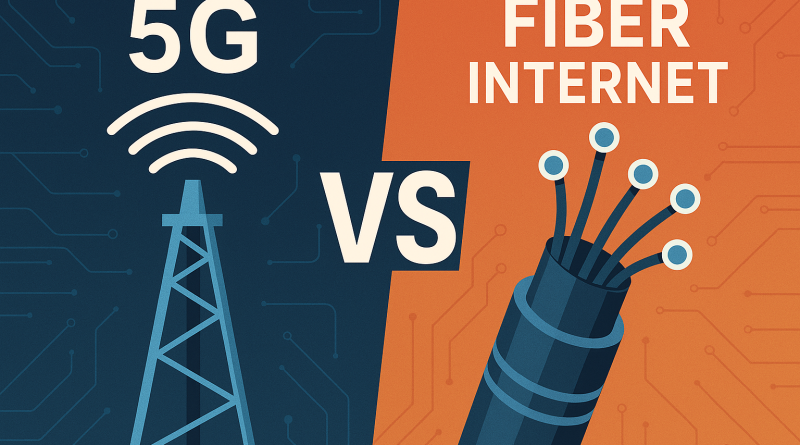5G vs Fiber Internet (2025): Which Is Better for You?
5G vs Fiber Internet (2025): Which Is Better for You?
Introduction: The Race for the Fastest Internet
India’s digital future depends on one essential factor — connectivity. As 5G expands across cities and fiber networks reach rural towns, users are asking the same question: 5G vs Fiber Internet — which is better? Both promise lightning-fast speeds and low latency, but they serve different purposes. Understanding their strengths and limitations will help you make the right choice for your home, office, or mobile setup.
What Is 5G Internet? 📱
5G (Fifth Generation Wireless Technology) is the latest evolution of mobile networks. It uses high-frequency radio waves to deliver ultra-fast speeds — often exceeding 1 Gbps — with extremely low latency (less than 10 ms). This allows real-time gaming, 4K streaming, and IoT connectivity without noticeable delay.
- Average speed: 300 Mbps – 1 Gbps (depending on coverage)
- Best use: Mobile users, remote workers, and travelers
- Key benefit: Wireless freedom and mobility
- Limitation: Performance depends on signal strength and network congestion
What Is Fiber Internet? 🌐
Fiber Internet uses optical fiber cables made of thin glass strands to transmit data as light signals. Unlike copper or wireless networks, fiber delivers symmetric speeds — meaning upload and download rates are equal — ideal for streaming, video calls, and large data transfers.
- Average speed: 200 Mbps – 2 Gbps (depending on plan)
- Best use: Homes, offices, gamers, and content creators
- Key benefit: Consistent and stable connection
- Limitation: Installation cost and limited coverage in some areas

5G vs Fiber Internet: Key Differences
While both technologies aim to provide high-speed connectivity, they differ in infrastructure, reliability, and long-term scalability. Here’s how 5G and Fiber compare on critical parameters:
| Feature | 5G Internet | Fiber Internet |
|---|---|---|
| Connection Type | Wireless (cellular) | Wired (optical fiber) |
| Speed Range | Up to 1 Gbps | Up to 2 Gbps + |
| Latency | 10–20 ms | 1–5 ms |
| Mobility | High (portable) | Low (fixed) |
| Reliability | Depends on signal strength | Extremely stable |
| Installation Cost | Minimal (requires 5G device) | Higher (needs cabling) |
| Best For | Smartphones, IoT, outdoor users | Homes, offices, and businesses |
Advantages of 5G Internet
5G is revolutionizing how we use mobile internet. Its major benefits include:
- Mobility: You can enjoy high-speed internet on the go, even while traveling.
- Quick deployment: No cables or installation delays; coverage expands via cell towers.
- Support for IoT: Enables connected cars, smart homes, and real-time monitoring.
- Great for rural areas: Can reach places where fiber is not yet available.
Advantages of Fiber Internet
Despite 5G’s convenience, fiber remains the gold standard for stable and ultra-fast internet. Its key benefits are:
- Unmatched consistency: Weather or signal issues don’t affect speed.
- Symmetrical speeds: Uploads are as fast as downloads — perfect for creators and streamers.
- Higher data limits: Many fiber plans offer truly unlimited data.
- Future-proof: Fiber can handle 10 Gbps+ upgrades with minor infrastructure tweaks.
Cost Comparison 💰
5G plans are usually bundled with mobile data packages, while fiber internet requires home installation. In India (as of 2025):
- 5G: ₹499 – ₹1,199/month depending on data cap and provider (e.g., Jio, Airtel).
- Fiber: ₹699 – ₹1,499/month for unlimited plans (e.g., JioFiber, Airtel Xstream, ACT).
While 5G offers flexibility, fiber often gives better value for heavy users who stream, work from home, or run small businesses.
Which Is Better for You? 🤔
Choosing between 5G vs Fiber Internet depends on your lifestyle and priorities:
- For mobility and convenience: Go for 5G — ideal for people on the move or in temporary housing.
- For stability and performance: Choose Fiber — best for offices, gamers, and streaming enthusiasts.
- For hybrid users: Combine both — use 5G for backup or travel and Fiber for home stability.
Future Outlook: 5G and Fiber Working Together
Experts believe that 5G and Fiber will not compete but complement each other. Fiber provides the backbone that powers 5G towers — without fiber, 5G cannot achieve full potential. Over time, both technologies will merge into a unified network delivering near-instant connectivity across India.
Government programs under Digital India and Department of Telecommunications (DoT) aim to extend both fiber and 5G coverage to every district by 2026. This will bridge the rural-urban digital divide and empower millions with faster, affordable internet.
Frequently Asked Questions (FAQ)
Q1: Is 5G faster than Fiber Internet?
In real-world usage, fiber still provides more consistent speed and lower latency, but 5G can be faster in certain mobile environments.
Q2: Can 5G replace Fiber for home broadband?
Not entirely. 5G is great for wireless use, but fiber remains superior for stable, high-bandwidth household connections.
Q3: Which is more affordable in India?
Fiber broadband plans often offer better data limits and cost efficiency compared to 5G mobile data packs.
Q4: What is the best option for rural users?
5G can be deployed faster in rural areas where laying fiber cables is difficult, providing high-speed access without infrastructure delays.
Conclusion: The Best of Both Worlds
When it comes to 5G vs Fiber Internet, there’s no single winner. Fiber provides unmatched reliability for fixed locations, while 5G brings flexibility and on-the-go performance. The smartest choice is to leverage both — fiber for home or business, and 5G for mobile connectivity.
In the coming years, India’s digital growth will depend on how effectively these technologies work together. Whether you stream, work remotely, or run an online business, having access to both ensures you’re future-ready in a world where speed is everything.
💡 Verdict: Fiber for stability, 5G for mobility — together, they define India’s connected future.
